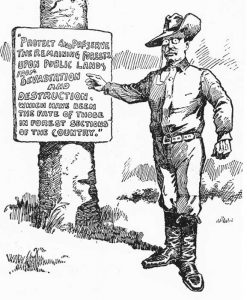The High Plains of southwest Kansas are known in history for the Santa Fe Trail, cowtowns, and its semi-arid terrain, which limited agricultural pursuits until the advent of irrigation. What it is not known for is any forest.
Things changed when President Theodore Roosevelt decided that the area would benefit from establishing a forest in this arid region in 1905.
Roosevelt, who believed that nature existed to benefit humanity, promoted the conservation of natural resources as part of his Square Deal program. Utilizing the 1891 Forest Reserve Act, which gave the President authority to create forest reserves from land in the public domain, Roosevelt designated 80,000 acres of land in the sandhills of Southwest Kansas as the Garden City National Forest Reserve in 1905. At the time, the idea did not seem far-fetched as the US Forest Service had considerable success in planting trees on the Nebraska Sandhills a few years previously,
Through Roosevelt’s plan, water could be used to irrigate semi-arid farmlands to grow forests where animals could be hunted for food and timber and used for building, and the hope was that the trees would draw moisture to the region.
The forest reserve in Finney County was just one of 150 national forests created by Roosevelt. Toward the end of his presidency, he had more than doubled the forest reserve acreage nationwide.
“We have fallen heirs to the most glorious heritage a people ever received, and each one must do his part if we wish to show that
the nation is worthy of its good fortune.”
— Theodore Roosevelt
Planting began in 1906, with 50,000 two-year-old yellow pines, 30,000 one-year-old honey locusts, hackberry, and Osage orange trees. Planting continued until approximately 1,000,000 trees had been planted. However, only 27% of the pine and 32% of the honey locust survived the first season, whereas all other species failed.
More trees followed the next year, but disaster struck when a prairie fire destroyed over 200 acres and many saplings. However, the Forest Service was undeterred and soon expanded the forest boundaries to 302,387 acres south of the Arkansas River in the sandhill region, which included parts of Finney, Haskell, Kearny, Grant, and Hamilton Counties and extended to the Colorado state line.
A federal nursery was established in 1908, two miles west of Garden City, and a government office was also established, with B.R.H. d’Allemand named as forest supervisor. D’Allemand was selected for this reserve because of his experience in forestry and grazing administration, and he assisted with nursery and planting operations in the Nebraska National Forest Reserve during 1903-1905. The supervisor had two assistants: one responsible for nurseries and the other for range administration. That year, the forest was renamed Kansas National Forest.
For several years, more trees were planted, with the goal of continuing until the entire tract was covered with saplings.
In 1911, two additional nurseries were established approximately 1 mile south of Garden City to test trees grown on heavy and sandy soils, using a variety of tree species, including pines, spruce, cedars, and hardwoods of different ages. However, a severe drought killed 90% of the trees that same year.
More trees were planted in the next few years, but they never grew taller than 2 feet. Jack pine, which had done very well in Nebraska, didn’t survive in Kansas due to severe drought, higher temperatures, and intense summer winds. Even the hardy red cedar died in droves. By 1915, it was clear that the experiment had failed, and President Woodrow Wilson abolished the forest.
In December 1915, approximately 3,200 acres were deeded to the state as a “big game preserve.” The rest of the land was opened for homesteading.
“All of the former Kansas National Forest is now grown up to soapweed, cactus, and clear, invigorating prairie air.”
— Topeka Capital, 1923
Today, the former game reserve is the Sagebrush Bison Range Wildlife Area. Managed by the Kansas Department of Wildlife and Parks, the first bison were brought here from Oklahoma in 1924. Today, it is the oldest publicly owned herd in Kansas.
The range lies approximately 1 mile south of Garden City and extends three miles back into the sandhills. In addition to the bison, various game birds call the area home. A few of the surviving trees are visible on the range.
©Kathy Alexander/Legends of Kansas, updated December 2025.
Also See:
Quirky Kansas
Sources:
Drake, Brian Allen; Forestry On The Kansas Grasslands, University of Nebraska, 2003.
Homestead Range
Kansas Geological Survey
Kansas Historical Society
Kansas Patriot



